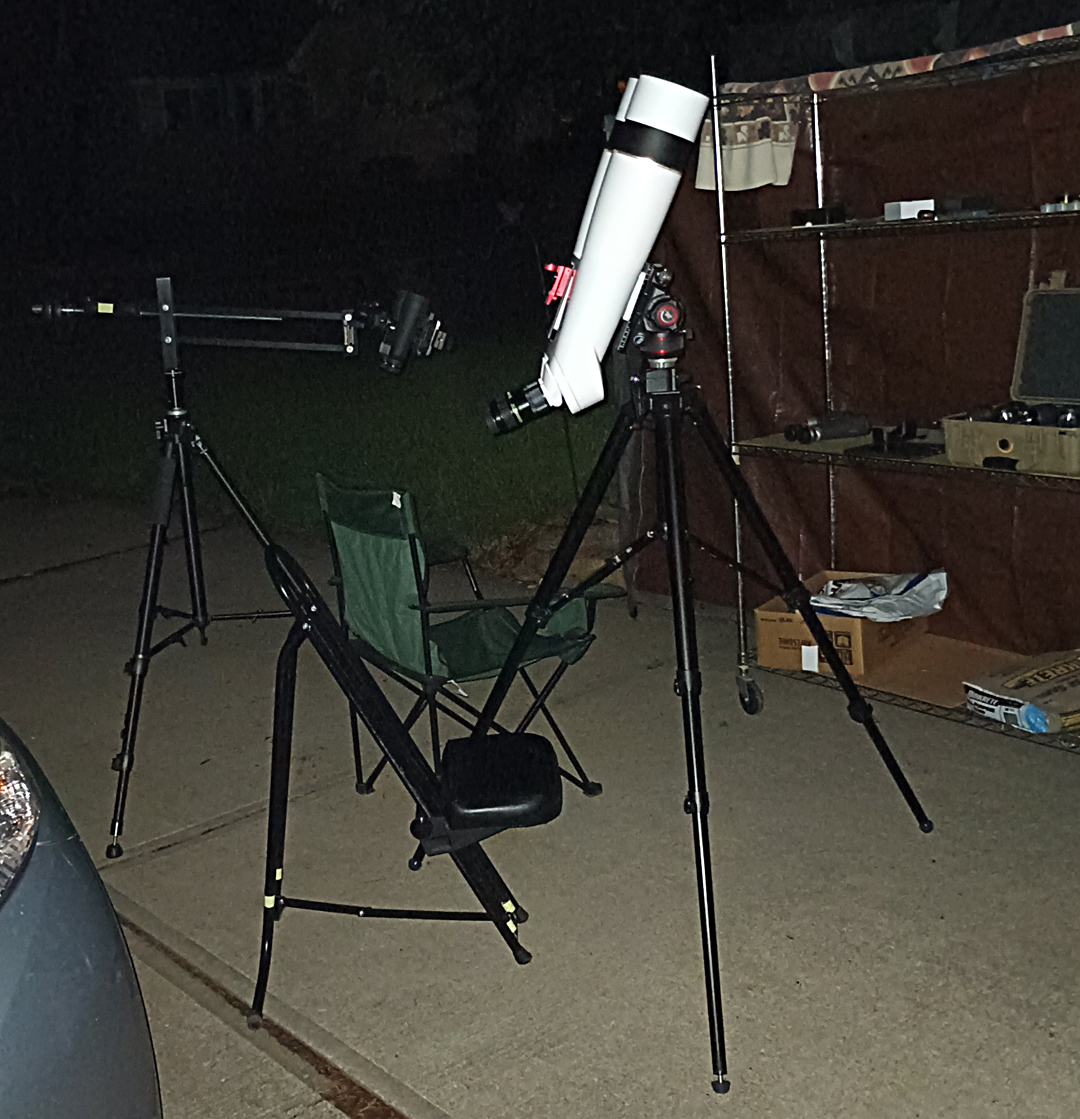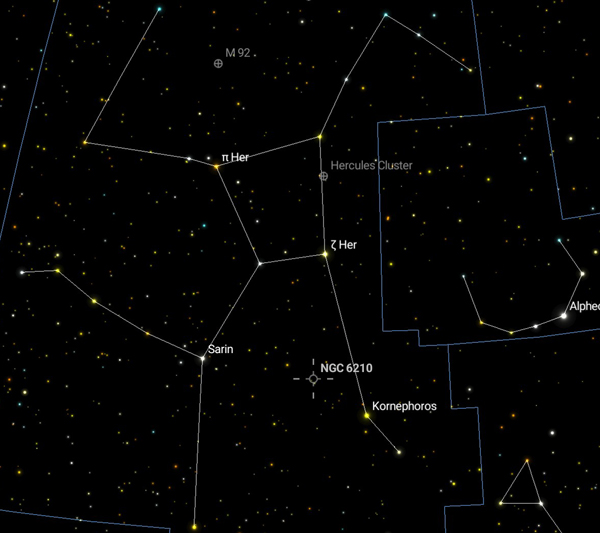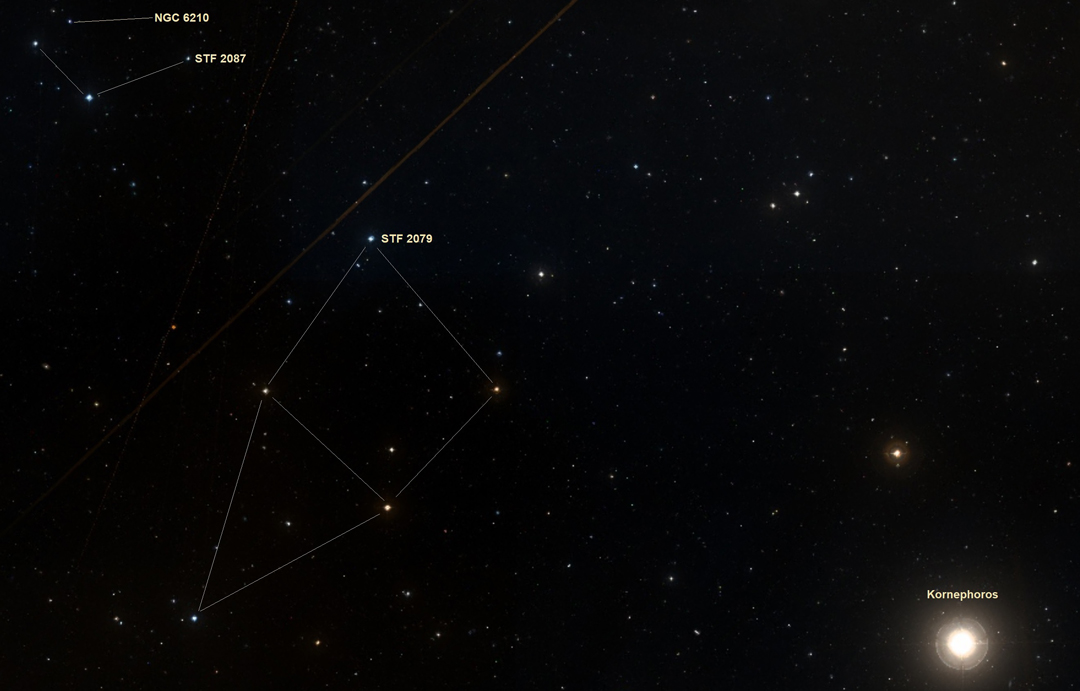A long anticipated arrival has occurred, and the Oberwerk 120XL-SD binocular telescope has returned to my Team BT, which now includes the full Oberwerk XL line-up (70XL-ED, 82XL-SD, 100XL-SD, 120XL-SD, and 127XL-SD). I evaluated the proto-type 120XL-SD several months ago but returned it to Kevin Busarow at Oberwerk for product photos and exhibition at the NEAF Space Expo in April. A production model arrived on Tuesday afternoon, June 6, 2023. I had a splendid first light session with it from my driveway that evening, despite somewhat indifferent, hazy skies (thanks to Canada wild fires).
I rolled out the Eastern light shield and also set up the Farpoint p-gram with Maven b.5 12x and 15×56 binoculars in supporting roles. The 120XL is shown here on a Manfrotto 475B tripod with an NT612 video head.

I started with Mizar in Ursa Major, easily resolved with the Morpheus 12.5s (52x / 1.46 degree FOV). And also observed Cor Caroli and M 3 in Canes Venatici, but these constellations were already somewhat disadvantaged from my driveway, so I shifted to the East. I could not(!!) see M 57 in Lyra. 😏 (The skies were that crappy.) But then shifted up to Hercules, first wandering around in the 100 Herculis region, which was fun. Then I decided to have a peek at NGC 6210 (a planetary nebula) which was a good idea since the Kornephoros star field is wonderful. Kornephoros is a Greek word meaning “club-bearer.” At 2.77 magnitude it is the brightest star in Hercules, but is designated Beta Herculis. Rasalgethi, the alpha star, is actually 3.36 magnitude.


The planetary was easily seen as non-stellar with a grayish blue tint. I also noted a distinctly orange star near it (TYC 2058-0280-1). Then noticed STF 2087, which is part of the triangular asterism used to locate the planetary. AND also STF 2079, which is a fine binocular double for 20x – also resolved with the 12x and 15x Mavens. Might be doable at 10x on a good night. And a splendid asterism that looks like the constellation Cepheus can be viewed between Kornephoros and NGC 6210, STF 2079 forms one corner of the asterism.
STF 2087
16h42m +23*40′
8.84/8.90 sep 5.3″ pa 287*
Optical double star
Distance: 175.66 LY / 181.54 LY
Spectral Type: G5IV / G8IV
Color Index: +0.71 yellow / +0.76 yellow
STF 2079
16h39m +23*00′
7.56/8.13 sep 16.7″ pa 91*
Physical double star
Distance: 454.66 LY / 453.88
Spectral Type: F0 / A5
Color Index: +0.38 yellow-white / +0.36 yellow-white
The Kornephoros / NGC 6210 experience captures what is so fun about binocular astronomy compared with telescopic observation. First, the planetary was a snap to find. Almost no effort at all. But, second, in all the years I have observed it (which is decades) not one single time(!) had I noticed the nearby doubles or the Cepheus asterism or paid anything more than cursory attention to Kornephoros — all of which is as much fun as the planetary itself. More, even. The difference to me is seeing the sky as a whole, instead of only looking at tiny fragments.
I had intended to make it a brief session, but observed for several hours and did not stop until after midnight. I am delighted with the 120XL. Its balance and stability on the relatively light Manfrotto 475B tripod is remarkable, even at higher magnifications. It is 5 pounds lighter than the 127XL, and also an inch longer (thanks to an f-ratio of 5.6 versus 5.1 for the 127XL). The difference might not sound like much, but the stability gain is significant. It was also one of my first sessions with the Morpheus 12.5s, with which I am equally pleased. They are comfortable to use and provide a wide field (the apparent field of view is reportedly closer to 78 degrees than the specified 76). The 120XL / Morpheus 12.5s / 475B+NT612 head is a dream setup. Easily moved around despite substantial aperture. A superb choice for suburban binocular astronomy.


Hello Fiske,
I am new to this website; it seems very informative thus far. I stopped by Oberwerk yesterday and spent about 20 minutes talking with Kevin about the BT-127 and BT-120. I also got to feel the difference in weight between the two. I am going to buy one or the other, with the Manfrotto tripod, elevator, and fork mount. I have also viewed most of Kevin’s videos and information on the Oberwerk website. Having viewed your posts on this website and the cloudy nights site, and since you have used both in a suburban night sky, I have a few questions, please;
1. Does the 127 have significantly more stabilization issues when using?
2. Since the 127 has about 12% more light gathering power, has it made a difference in your viewing?
3. Is the quality of the view noticeably better in the 127 (triplet)vs the 120 (doublet)?
Thank you for your time and expertise!
Sincerely,
Pat
Hi, Pat. Thanks for visiting my blog. You can’t go wrong either way, choosing between the 127 and the 120XL-SD binocular telescopes. 😉
Here are my responses to your questions.
1. Yes, the 127XL is more challenging to stabilize than the 120XL. If you are considering the Manfrotto 161MK2B tripod, it is sturdy enough to handle the 127XL. I really love the Oberwerk XL280 fork as well. BUT, there will be some shake to cope with. When I observe with the 127XL, I typically use an iOptron Tri-tier with an AZ Pro goto head — goto reduces problems with shake because you don’t have to manually reposition the BT. If you’re looking at the Manfrotto 475B tripod, my favorite BT tripod, I would advise going with the 120XL. Which, honestly, I use much more frequently than the 127XL because it is a lot easier to deploy.
2. Yes, the 127XL does go a little deeper in urban/suburban skies, which is part of the reason I love it so much. But the 120XL goes reasonably deep as well. The difference is there, but it doesn’t prevent me from using the 120XL a lot of the time.
3. Optically, both BTs are excellent. I tend to use BTs, and particularly larger BTs at low to moderate magnification levels, say in the 30-75x range. Some observers like to push BTs to much higher magnifications, but I find that to be a lot of work, honestly. 😆 For one thing, I observe wearing glasses, and aligning two small exit pupils while viewing with glasses is not a trivial effort. At the magnification levels I use with these two instruments, if there are optical quality differences at all, they are subtle indeed. Possibly, there might be a noticeable difference at higher magnifications, but such observing will be such a small percentage of your overall usage that my advice is not to worry about the triplet vs doublet difference. In fact, IMO, the use of triplet objectives adds weight to the front of the BT, which is a contributor to the stability difference between the two.
So that is my take on the 127XL vs 120XL. Honestly, I would not be without either one of them. But then, I own the full Oberwerk XL BT line. 😁 I think you would be quite happy with the 120XL. If you have not owned a BT yet, I would encourage you to think carefully before opting for the 127XL.
Thank you Fiske,
I appreciate your reply. I have not used the BT’s yet; I have had the Oberwerk 25×100’s for the past couple of years so this will be my upgrade. It’s nice to get your experienced answers from the field. I will likely go with the 120’s then, and an added bonus is they will be just light enough for me to port them to a nearby darker observing site. Thanks for helping me to clarify my decision!
Pat
Pat, the 120 is the BT I take most often to dark sky sites. I use the 127XL mostly from my urban yard.
Good luck with your binocular telescope adventures! 😊